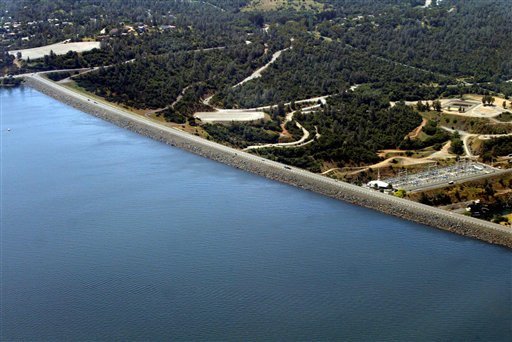The state said Thursday it would cut water deliveries to their
second lowest level ever, prompting warnings of water rationing for
cities and less planting by farmers.
SAMANTHA YOUNG – Associated Press Writer
SACRAMENTO
The state said Thursday it would cut water deliveries to their second lowest level ever, prompting warnings of water rationing for cities and less planting by farmers.
The Department of Water Resources announced it will deliver just 15 percent of the amount that local water agencies throughout California request every year. That marks the second lowest projection since the first State Water Project deliveries were made in 1962.
Farmers in the Central Valley say they’ll be forced to fallow fields, while cities from the San Francisco Bay area to San Diego might have to impose mandatory water rationing.
Mike Young, a fourth generation farmer in Kern County, called the water projections disastrous.
“For the amount of acres we’ve got, we’re not going to have enough water to farm,” he said.
The reservoirs that are most crucial to the state’s water delivery system are at their lowest levels since 1977. That follows two years of dry weather and court-ordered restrictions on water pumping out of the Sacramento-San Joaquin Delta. This year, water agencies received just 35 percent of the water they requested.
Lake Oroville, California’s second largest reservoir, is usually half full this time of year but is at just 30 percent capacity.
In Southern California, the Metropolitan Water District – the agency that supplies water to about half the state’s population – has depleted more than a third of its water reserves. The agency’s general manager, Jeff Kightlinger, said Californians must immediately reduce their water use to stretch what little water is available.
“We are preparing for the very real possibility of water shortages and rationing throughout the region in 2009,” Kightlinger told reporters in conference call.
He said his board will consider rationing during its meeting next month.
The State Water Project delivers water to more than 25 million residents and 750,000 acres of farmland.
In 2006, water agencies received their full allotment, in part because of heavy rains and a thick Sierra snowpack that year. But last year, a federal court limited water pumping out of the delta to protect the threatened delta smelt.
Department of Water Resources Director Lester Snow said the bleak outlook underscores the governor’s call to retool California’s massive water storage and delivery system.
Gov. Arnold Schwarzenegger favors building more dams and designing a new way to funnel water through or around the environmentally fragile delta. The proposals have failed to gain traction in the Legislature.
Earlier this year, Schwarzenegger called on water agencies to voluntarily cut their water use 20 percent by 2020. He has stopped short of issuing a mandatory conservation order, a strategy that has never been used by the state, Snow said.
“Our strong preference is that the regions design a program that best fits their own needs,” Snow said. “If things get worse, we will take additional action.”
Even with Thursday’s dire projection, a wet winter could mean cities and farms ultimately get more water, said Ted Thomas, a spokesman for the state water department.
That was the situation in 1993, when the state promised contractors just 10 percent of their requests, the lowest initial projection on record. That later was revised to 100 percent after the state received heavy precipitation.
Unlike then, state and federal water agencies are under a court order to cut pumping from the delta because a federal judge last year ruled that the giant pumps were harming threatened fish.
“We are anticipating drastically reduced water supplies, regardless of weather conditions,” Laura King Moon, assistant general manager of the State Water Contractors, said in a statement.
Farmers also are making decisions now on what to plant next year. Based on the state’s initial projection, Young, the Kern County farmer, said he will be forced to fallow a fifth of his 5,000 acres.
The little water coming to him will go to his permanent crops – pistachio, almond and cherry trees – while most of his tomatoes and alfalfa will not get planted.
“We’ve got to start spending money on next year’s crop now,” Young said. “Anyone whose pulling water off the State Water Project is going through the same thing.”
Jim Beck, general manager of the Kern County Water Agency, said farmers fallowed some 20,000 acres this year. He estimated 50,000 acres would be fallowed next year and another 40,000 acres of permanent crops would yield less fruit and nuts.
Fewer crops will mean fewer farm hands needed to plant, maintain and harvest them.
“We’re seeing a phenomenon in the Central Valley where growers who have been in the business of agriculture are laying off workers who have been with them for 20 or 30 years because they don’t have the water,” Beck said. “It’s one thing to see brown lawns and shorter showers in urban areas. The real impact in the Central Valley is people are having to find new jobs.”














